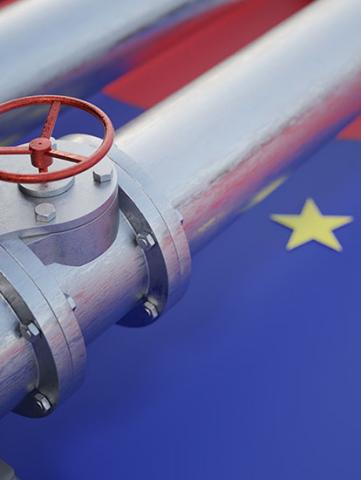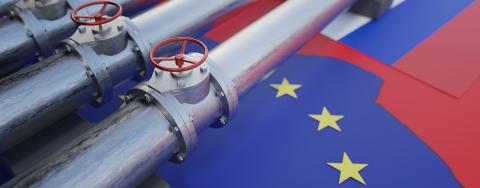

What Are the Solutions for Reducing Our Imports of Russian Hydrocarbons?
Interview with geologist Isabelle Moretti.
La guerre d’Ukraine conduit l’Europe à s’interroger sur sa dépendance énergétique et à remettre en cause sa stratégie pour les prochaines décennies. Isabelle Moretti, vice-présidente du pôle énergie de l’Académie des technologies et chercheuse associée à l’ISTeP1 , The war in Ukraine is leading Europe to question its energy dependence and its strategy for the coming decades. Isabelle Moretti, vice-president of the Académie des technologies' energy pole and associate researcher at ISTeP1, sheds light on the issues at stake and the possible short- and medium-term solutions for greater energy autonomy.
The conflict in Ukraine has reminded us that we are partially dependent on Russian gas, oil and coal imports. What is the importance of these imports in France and Europe and what are they used for?
Isabelle Moretti : While nearly half of the gas imported into Europe comes from Russia, Russian gas only represents 17% of imports into France, far behind Norwegian gas (36%). As for French oil, 12% comes from Russia, 15% from Saudi Arabia, 14% from Kazakhstan, 12% from Nigeria, 11.7% from Algeria and the rest from Norway. We also import 30% of our coal from Russia to produce steel, cast iron and electricity—13 million tons, which is relatively small.
These hydrocarbons are used for many industrial processes, but also for mobility, heating, lighting, and more. In order to gradually move away from coal, the European decarbonization strategy relies on an increase in gas which, because it generates three times less CO2 than oil—and much less than coal—is considered a transition energy.
What would be the alternatives to reduce our energy dependence on Russia in the short term?
I. M. : To reduce Russian hydrocarbon consumption in the short term, we can first reduce our own consumption. Energy sobriety means reducing the temperature of our homes. According to the International Energy Agency, lowering the heating thermostat by one degree in all European homes, offices and commercial premises would reduce gas demand by about 10 billion cubic meters per year.
The second solution is to bring in hydrocarbons from other countries, which implies finding sellers and transportation routes. With shale gas, the United States has gone from being the largest gas importer to the largest producer in twelve years, ahead of Russia and the Middle East. Currently, half of the gas transport is done in pipelines and the other half by ships. While it is impossible to build a gas pipeline in one year, we can bring more ships to our ports to deliver liquefied natural gas (LNG). This is the strategy that Poland has adopted in recent years by creating new ports to reduce its dependence on Russian gas. Conversely, Germany is the only European country without LNG terminals to import LNG despite having access to the sea.
And in the medium term?
I. M. : Biogas is a solution that is gaining momentum. First-generation biogas is produced from wet waste, sewage sludge, for example. It can either be burned directly or be used as a fuel for the production of electricity. It can then either be burned directly to produce electricity and heat, or purified to be injected into the network (there are currently nearly a hundred injection points in the French network).
The second generation of biogas is obtained by pyrolysis of dry organic matter (by burning plastics or the remains of furniture, for example). It requires heavier installations, but they are being deployed in France. Given the significant quantities of waste we produce, we can imagine biogas production in the form of short circuits in the medium term.
Another promising technology is synthetic gas made from a mixture of hydrogen and CO2. Near Marseilles, a pilot system has been launched to neutralize, thanks to hydrogen, the CO2 coming from a polluting industry and transform it into gas. Hydrogen is a solution of the future that could really change the game. The natural hydrogen present in the ground, and on which I have been working on for several years, is a cheap source of energy that we hope will be available in large quantities. It can be used for many purposes such as mobility, CO2 neutralization and chemistry.
What place is given to renewables to move towards greater energy autonomy?
I. M. : Our leaders are faced with a complex problem: they must, simultaneously, reduce greenhouse gas emissions, gain energy autonomy, and produce inexpensive energy with minimal risk.
Renewable technologies are developing fast—especially in India and China—even though these countries keep open coal-fired power plants every day because of the low cost of this energy source. In France, we have solar, wind, hydro, biomass, ocean energy, etc. However, the deployment of these technologies has obstacles. First, the cost of development: today, marine energy remains expensive. But when you look at the curves showing the decline in the price of photovoltaic and wind energy over the last thirty years, you see that prices drop drastically when the technology becomes mature. Solar energy is now a competitive energy. We must therefore continue working to bring down costs.
In addition to the cost problem, there is cultural and societal reticence. Some technologies, such as geothermal energy, are not widely used in France, whereas they are widely used in other countries. In the Netherlands, for example, half of all houses are equipped with a heat storage system, whereas in France these installations are present in 0.01% of homes. Another example: the installation of wind turbines on French territory or on its coasts often requires years of negotiation before it can be agreed upon.
Better energy independence also requires the awareness of all citizens who must understand that energy does not fall from the sky and that its generation can have impacts. If the majority of citizens do not want windmills, solar panels, biogas, dams or power plants, then the only alternative will be to import energy from our neighboring countries.
The energy problem is a complex and multifaceted one. The war in Ukraine has changed the situation, but it is essential to take the time to reflect so as not to choose solutions that could prove inappropriate in the future.
1 Paris Institute of Earth Sciences (Sorbonne University, CNRS, Institut National des Sciences de l'Univers)
